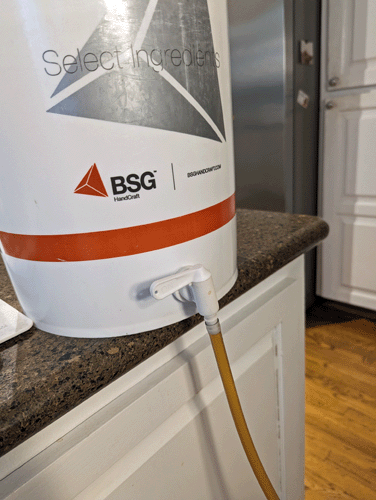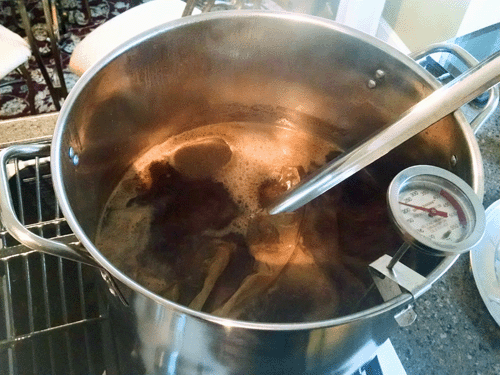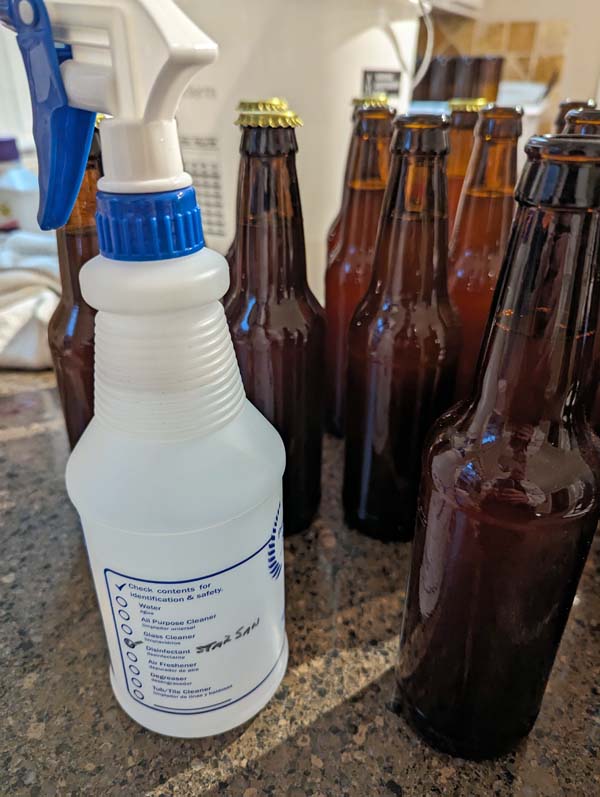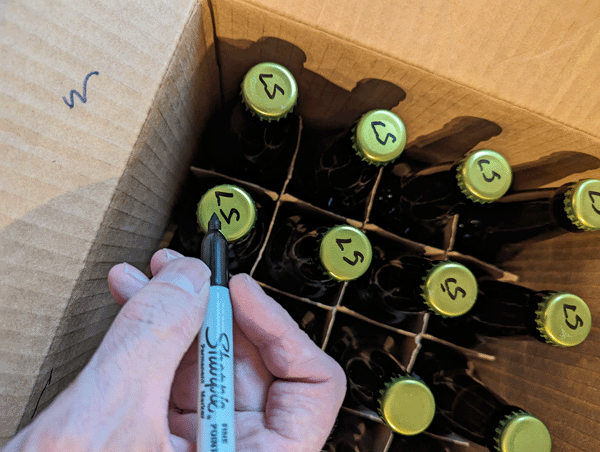
Last Updated on January 27, 2024 by Doug Hall
Just bottled our latest brew

Just bottled our latest beer. It was a Belgian Whit beer extract recipe for a Shock Top type of knockoff I bought at More Beer. The recipe was titled Lunar Shock. It is an Americanized variation of a Belgian Wit beer.
This is the second time I have brewed this recipe. It was amazing the first time. I actually bought some Shock Top and asked a neighbor to do a blind taste test with our Lunar Shock homebrew versus Shock Top.
The most common comment for the Shock Top was that they thought it was it was some sort of a light beer (that’s not a compliment). Tasting the homebrew Lunar shock I received comments like, so much flavor, really taste the orange, great color.
They were gobsmacked to discover the ‘light beer’ was actually a Shock Top. They had very favorable things to say about Shock Top prior to the blind taste test. I’m not knocking Shock Top, it’s just that there seems to be a cheapening of the overall flavor and quality of ingredients used by major commercial breweries.
This was a 5-gallon batch. The recipe included:
- 7 pounds of Bavarian Wheat Malt Extract
- Specialty Malts: 1 pound Flaked Oats and 1 pound cracked 2-Row Pale
- 1 oz Mittelfruh hops
- 2 oz of sweet orange peel
- 1.7 grams coriander powder

I also bought a 5 ounce bag of corn sugar (Dextrose). That is boiled and added to the bottling bucket to generate carbonation in the bottles.
Low Cost per Bottle!
Including the yeast and corn sugar, the recipe cost $31.60. That is an average of $0.62 per bottle. I already had bottles, caps and anything else I needed for the process.
I started by measuring and pouring 2.5 gallons of water into our brew pot. I normally use tap water. Since the water will be boiling, I just figured any impurities that could affect taste will be cooked out.
While the water was warming up, I steeped the specialty grains for up to 30 minutes or until the temperature gets to 170 degrees.
This second time around, I upped the amount of orange peel from 2 to 3 ounces. Just personal preference, and a desire to see how much of a difference it would make. I also only used about 75% of the coriander the first time. I used it all this time but I added the final 25% at the end of the boil versus the instructions to add with 10 minutes were left in the boil.
Other than that, I followed the simple step-by-step instructions provided. Cooling the wort (fancy word for unfermented beer) in an ice bath in a kitchen sink. It just has been the best cooling method for me. I know a lot of people use wort chillers, but that just won’t work for my setup. I always have 3, 1-gallon containers of filtered water cooled in my refrigerator.
I’ll add the first chilled one-gallon of water into the brew pot as I stir the wort in the ice bath. It takes less than 15 minutes for the temperature to get below 110 degrees.

Sanitize Everything!
While the wort is colling off, I sanitize the fermenting bucket, the lid, air lock, yeast packet and the scissors used to open the yeast packet. My go to sanitizer is Star San. I always have a 32 ounce spray bottle of the solution, making it easy to spray down and sanitize everything.
Once sanitized, I add most of the other 2 chilled gallons to the fermenting bucket. Once I pour the wort into the fermenter, and aerate it, the temperature is always in the 70 to 75 degree range. For an ale recipe, that is a good temperature to pitch the yeast. I’ll top it off if needed, to get the total volume just above the 5-gallon mark.
I’ll take a gravity reading and make a note of the original gravity. Then pitch the yeast, sprinkling around the top of the wort. Seal the lid with the air lock in place.
I left my Lunar Shock in the primary fermenter for 19 days before bottling. In the middle of winter, our coat closet keeps a pretty steady temperature in the mid 60’s. Perfect for the CellarScience® CALI Dry Yeast | American Ale | Premium Beer Yeast I used. It can do its thing up to 72 degrees but around 65 is optimum.
Bottling
Bottling is a process that takes me about 90 minutes from start to finish. I have acquired a few gadgets that makes the cleaning and sanitizing of the bottles a bit easier but it just takes time to sanitize everything, boil the sugar, rack the beer, bottle and cap two cases of the latest golden elixir.

Everyone has their own technique for labeling their bottles to know what is inside. I simply use a Sharpie & add a 2 letter abbreviation for whatever the style or recipe name was. In this case, I added LS, for the Lunar Shock recipe name.
Yes, those are supposed to be an ‘L’ and an ‘S’. Bottling 2 cases of beer is usually a 2-beer consumption process for me. There’s also at least a pint left in the bottom of the bottling bucket. Sure, it has some sediment, is room temperature and flat, BUT it is a great way to get a good taste test of your new batch.
I leave the 2 cases of beer to age in closed boxes and at room temperature.
A lot of homebrewers I speak to let their beers age in the bottle 2 to 4 weeks before trying one. It is true, most beers do mellow with some age, but I’m too impatient.
I’ll try the first beer after 7-days. If I get that gratifying woosh sound when I pop the top, they are fair game to drink.
All-in-all, I have about 4 hours of time and $31.60 invested into 2 cases of fresh, flavorfull craft beer. As the saying goes; life is short, drink good beer. Cheers!
I’ll update this post after I have had a chance to try the new & improved (hopefully) Whit Beer.
UPDATE
After 7 days, the carbonation wasn’t close. It’s now been 3 weeks and the beer is carbonated, there’s just not a lot of head.
The added orange peel definitely comes through in the flavor. It’s almost a bit too much of an orange pithy flavor. A slight fruit bitterness. It’s not bad. I have a neighbor who loves it. I prefer the original recipe.
Overall Characteristics:
Color (SRM): 12
Bitterness (IBU): 9
ABV: 5.4%
Other notes: Definitely a more fruity nose with the added orange peel. Malt forward with a hazy appearance from the oatmeal steeping grains. Little to no hoppy flavor.
- Belgian Amber Ale Recipe Review - May 14, 2024
- How to Choose the Right Beer Glass - May 14, 2024
- 2024 Top Beer Delivery Services - May 10, 2024
